
When thinking about the world’s top culinary destinations, one’s mind undoubtedly drifts to Tuscany. Rolling hills littered with olive trees, dairy farms handcrafting Pecorino cheeses and rows upon rows of Sangiovese grapes. During a stay at Castello di Gabbiano I was fortunate enough to enjoy an array of food- and wine-themed experiences, one of which was a traditional Tuscan cooking class focused on Tuscan olive oil.
Tuscan cooking is rooted in tradition, specifically peasant-style cooking with no ingredients being wasted. Additionally, there’s an overarching idea that fresh, local ingredients and homegrown herbs and spices can bring out a dish’s intense flavors. You’ll often find lightly-fried vegetables, steak, wild boar, mushrooms, truffles olives, artichokes and pecorino cheese as well as herbs like rosemary, thyme, basil and sage are common ingredients found in Tuscan cuisine. Typically, dishes are paired with local wine — typically red, as Tuscan dishes tend be rich and heavy in red meat — which has been part of local tradition for over 3,000 years. The castles — like Castello di Gabbiano — showcased throughout the landscape pay homage to a time when Siena and Florence fought for control of this flourishing land.
The cooking class is led by Executive Chef Paolo Nucera and Sous Chef Erez Chayon, who are teaching us in an interactive fashion the importance of cooking with olive oil in Tuscany.

Chef Paolo Nucera
Starting With Dessert
We begin by preparing the dessert, a treat called “Torta all’olio d’oliva,” which literally translates to “olive oil cake.” While to Americans this may sound like an odd pairing, we’re enlightened on the importance of quality when it comes to the ingredient. In Tuscany, the highest grade of olive oil is extra virgin, which must meet very restrictive requirements, including being extracted at a lower temperature of 27°C (81°F) and within 24 hours from picking. The oil must be obtained by mechanical cold pressing — without the addition of solvents — during the first pressing of the olives and bottled immediately. Despite popular belief, extra virgin olive oil is used for cooking due to its high melting point and richness in Omega-3s.
To begin the class, Chef Paolo places four eggs, brown sugar and vanilla into a bowl before instructing us to whisk the batter.
“You want to whisk the batter quickly and for a long time,” says Chef Paolo. “This helps add air to the batter and gives the cake a nice lightness.”
Fresh orange zest, baking powder and olive oil are added during the process before the cake is placed in a circular cake pan and put in the oven at 170 degrees Celsius (about 340 degrees Fahrenheit) for 40 minutes.
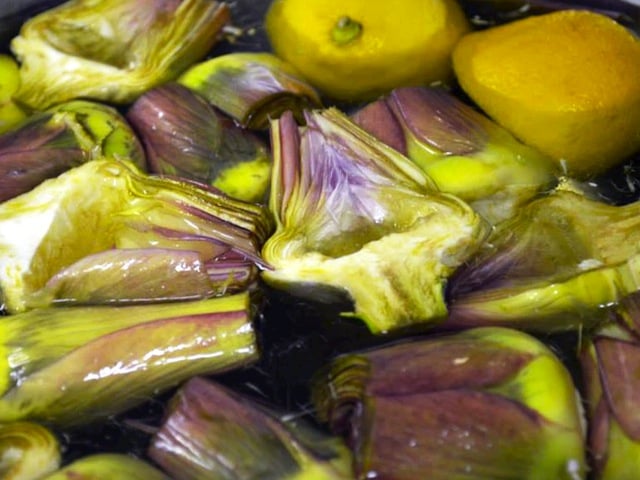
Artichokes in lemon water
The Secret’s In The Fresh Ingredients
While the cake is baking, the group begins on the starter, an antipasto salad featuring a simple recipe that makes me wonder how I haven’t thought of it myself. The appetizer contains artichoke, crispy bacon, Pecorino cheese, fresh olives and garden herbs like lemon thyme, regular thyme, rosemary, sage, chives and white garlic. Essentially, it’s a showcasing of Tuscany’s most beloved ingredients. It’s topped with salt, a squeeze of lemon, parsley and just-pressed olive oil for a more robust flavor. The difference between this salad and the kinds I eat back in New York is clear: The freshness of the ingredients and heart-healthy olive oil — not the over-processed meats and dressings — creates a strong flavor in a natural way.
The taste is also affected by the love that goes into crafting such a salad. Each artichoke is peeled until thick green leafs become delicate white and purple. From there most of the stem is removed and the vegetable is cut in half. Like a doctor performing surgery, I remove the fuzzy inside, which can leave a bitter taste. Each meticulously prepared artichoke is placed in a pot of cold lemon water to soak and soften, before being finely diced to create the base of the appetizer. Cured Tuscan ham is fried to add a diversity in texture and taste, while the Pecorino — a traditional Tuscan cheese — contributes a sharp, salty flavor. For a bit of contrast, a sweet balsamic is drizzled on top.

Making handmade pasta
Making Pasta By Hand Is Simpler Than You Think
The group is brought to a special pasta-making room where there’s not much other than a wooden table — perfect for rolling hand-made pasta on — and a machine that shapes pasta when necessary. Today we’re making cavatelli using a bran-based semolina flour, which has a soft texture that’s easy to roll by hand. One major difference between semolina and regular white flour is the water temperature for semolina must be extremely hot to make it starchy. Work the ingredients together — once the water has cooled a bit — and begin kneading it into a dough.
“You’ll need to do this for about 10 minutes using your upper body strength to let the hot water begin cooking the pasta. It’s a great stress reliever,” laughs Chef Paolo, as he works his muscles into the rolling.
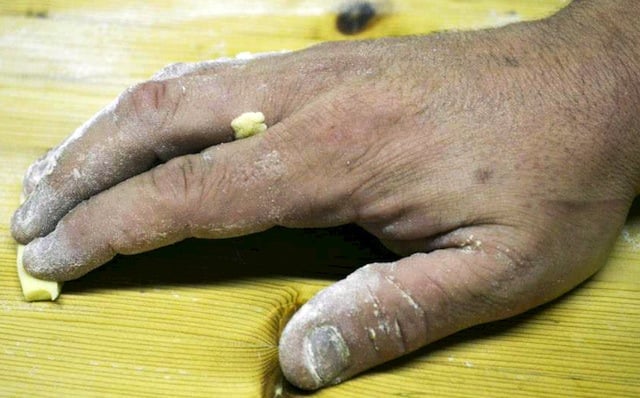
To make cavatelli pasta, roll the dough with three fingers
Because the dough’s texture is soft it’s best to hand-roll the pieces, which we do by cutting the dough with a cleaver-like knife into pieces about the length of three fingers. The technique for shaping cavatelli is to gently press three fingers into the dough and roll it back while pulling the mixture toward you, creating a long pocket in the pasta. While it takes me a few tries to not have it look like a smushed worm, I finally get the hang of it once I pull the dough back for longer and slower. For some added flavor, Tuscan olives, sun dried tomatoes and other local products can be added to the dough.
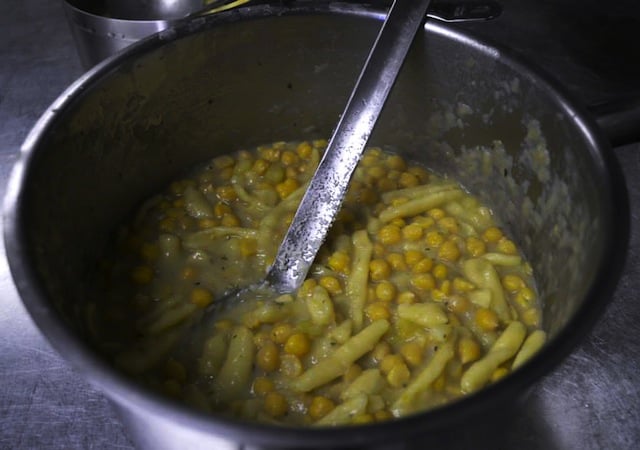
Chic Pea Soup cooking
A Different Kind Of Soup
We don’t add any ingredients, however, as the pasta is being incorporated into our next creation: Chic Pea Soup. While I’d always thought of soups as being liquid-based, Chic Pea Soup is much more like a thick stew or porridge. This is thanks to the potato starch, which contributes a creamy element.
To make the soup, olive oil, crushed garlic, pork fat, diced potato and 1 kilogram of chic peas — enough to serve 15 people — are added to a pot along with chicken stock. The flavorful concoction is cooked on medium heat, before a tantalizing dressing of garden herbs fried in fresh olive oil is added to the dish. Because not everyone enjoys heavy garlic, the cloves are taken out, while the handmade pasta is added.
The result is a soup that’s much different than what I’m used to at home — in a good way. First of all, there is no broth, making it heartier and more satisfying. As for flavor, frying the herbs in olive oil gives them a richer character than simply dropping them in or boiling them would. Overall, it’s a satisfying Tuscan soup experience that shows me the benefits of cooking with olive oil.

Cooking the Pollo al Mattone
Simple Ingredients, Big Flavor
I’ve never been an expert when it came to cooking — especially elaborate meat dishes; however, creating the main course of Pollo Al Mattone, which means “chicken under a brick,” makes me realize fresh ingredients can make a dish seem more embellished than it really is. Under the direction of Chef Erez, an entire chicken is de-headed, cut along the joints and de-boned.
“Don’t get rid of the bones,” Chef Erez instructs, reminding me of their peasant-style culinary philosophy. “They add flavor to soups and broths you make later on.”
Skin is kept intact to keep the meat from burning, as well as to add a crispy element to the dining experience.
Next, the chicken is opened like a book and salted before being placed on a frying pan coated in olive oil, garlic, salt, garlic, rosemary and sage. A piece of baking paper is placed over the chicken, while another frying pan presses the meat down hard over the flame for quicker cooking. Immediately the kitchen fills with the sound of sizzling and the smell of crackling poultry. After the chicken is flipped, it’s baked at 175 degrees Celsius (about 350 degrees Fahrenheit) for 12 minutes while still in the pan.
I think to myself how the process isn’t much different from how I would cook chicken at home — aside from the whole beheading part, which actually isn’t so bad if you have a sharp knife. The main difference is the amount of local herbs and olive oil used in the preparation, an uncomplicated step leading to a complex explosion of flavor. The Pollo Al Mattone is gowned in Tuscan olives, chicken stock and extra herbs fried in the oil left over from the pan. Again, nothing goes to waste in Tuscany.
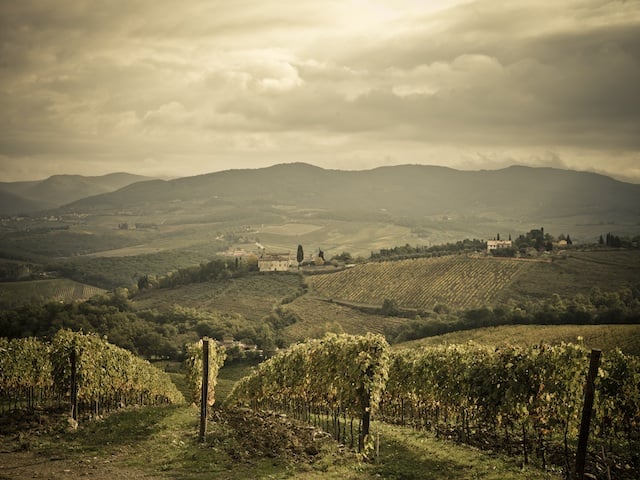
Enjoy beautiful views while you eat. Photo courtesy of Castello di Gabbiano.
A Meal With A View
After the class the group is led to Castello di Gabbiano’s onsite restaurant, Il Cavaliere. Located on a hilltop in a 16th-century farmhouse, I’m taken back in time with stone walls, dramatic arched doorways and exposed wooden beams. Through the many floor-to-ceiling windows, the rolling hills and onsite herb and produce garden add a visually appealing element to the experience.
Each course is paired with a wine, as the property is home to Gabbiano Winery and Vineyards. Located in the heart of the Chianti Classico Region, their winemaking is inspired by traditional Tuscan methods blended with contemporary innovations.
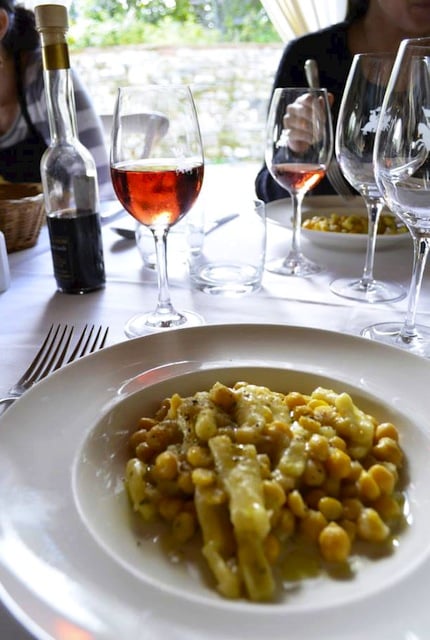
Chic Pea Soup with Wine
We begin with the salad and soup, which is served with a 2012 Gabbiano Rose. Composed of 70% Sangiovese and 30% Merlot, the wine shows how the historically simple Sangiovese grape can also have a versatile side. The icy cold drink, with its floral nose, flavors of cherry and red berries, and crisp, dry finish offset the earthiness of the appetizers for a perfect pairing.
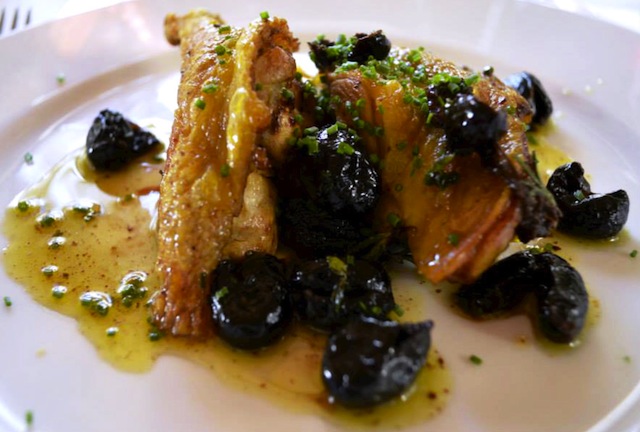
Pollo al Mattone
Next there’s the main course, Pollo Al Mattone, with its juicy inside and crispy outside. A smokey yet bright taste presents itself with each bite, which is complemented by our next wine, a 2011 Castello di Gabianno Chianti Classico made with 100% estate grown grapes, over 90% of which are the local specialty, Sangiovese. Served at 18 degrees Celsius (31 degrees Fahrenheit), the room temperature wine features an intense ruby red color, spicy yet floral aroma, and flavors of cherry jam and pepper. The wine’s dry and high acidity qualities make it a food-friendly choice that can stand up to intense herbs and spices.

Olive Oil Cake
And with our fluffy Olive Oil Cake, we are served a slightly sweet Gabbiano Moscato d’ Asti. An effervescent and complex wine with a straw yellow color, it contains notes of dried fruit, orange blossom and sage, which mimic the tastes in the dessert and intensify the flavors.
As I sip my wine, staring out into the hills and woodlands that showcase the ingredients of my meal, I feel healthy and more connected to local culture. There’s something oddly satisfying about dishes where simple, fresh, local ingredients speak for themselves in a way that reflects local heritage in the purest way possible. It’s cultural immersion at its most natural.
Castello di Gabbiano’s cooking classes are offered for 110 Euros ($150 USD) per person for a one-day class and 280 Euros ($381 USD) per person for a three-day class.
Olives ready to be pressed. Photo courtesy of Gabriele Tudico and Featured image courtesy of USDAgov
My trip to Tuscany was sponsored by Castello di Gabbiano. I was not required to write this post nor was I compensated for it. All opinions are my own.

Jessica Festa is the editor of the travel sites Jessie on a Journey (http://jessieonajourney.com) and Epicure & Culture (http://epicureandculture.com). Along with blogging at We Blog The World, her byline has appeared in publications like Huffington Post, Gadling, Fodor’s, Travel + Escape, Matador, Viator, The Culture-Ist and many others. After getting her BA/MA in Communication from the State University of New York at Albany, she realized she wasn’t really to stop backpacking and made travel her full time job. Some of her most memorable experiences include studying abroad in Sydney, teaching English in Thailand, doing orphanage work in Ghana, hiking her way through South America and traveling solo through Europe. She has a passion for backpacking, adventure, hiking, wine and getting off the beaten path.








